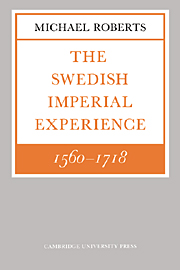III - The character of the empire
Published online by Cambridge University Press: 06 January 2010
Summary
by 1660, then, the empire had attained its limits and assumed its final form. In comparison with those empires which were simultaneously taking shape in the East Indies and beyond the Atlantic, it was no doubt of modest dimensions: metropolitan Sweden (to say nothing of Finland) covered a much greater area than the provinces which had now been added to it. But it was, nevertheless, quite big enough: too big, indeed, for ease of integrated government. To the citizen of Stade or Dorpat, Stockholm must have seemed reassuringly remote; and for the purposes of administration – as likewise for the direction of continental war – it was certainly inconveniently peripheral: already in the 1630s Salvius was suggesting transferring the direction of foreign affairs to Hamburg, since that city was at once the centre of financial operations, a nodal point in the European postal system, and a base for Swedish political and commercial espionage; and at about the same time Axel Oxenstierna toyed with the notion of establishing a second capital – a kind of Swedish Byzantium – at Narva. Nothing came of these ideas; but they serve to remind us of the physical difficulties in the way of a measure of control of this aggregate of heterogeneous territories. The Swedish empire does not fit easily into any political category: its closest analogue, perhaps, is the empire of the Habsburgs.
- Type
- Chapter
- Information
- The Swedish Imperial Experience 1560–1718 , pp. 83 - 122Publisher: Cambridge University PressPrint publication year: 1979

